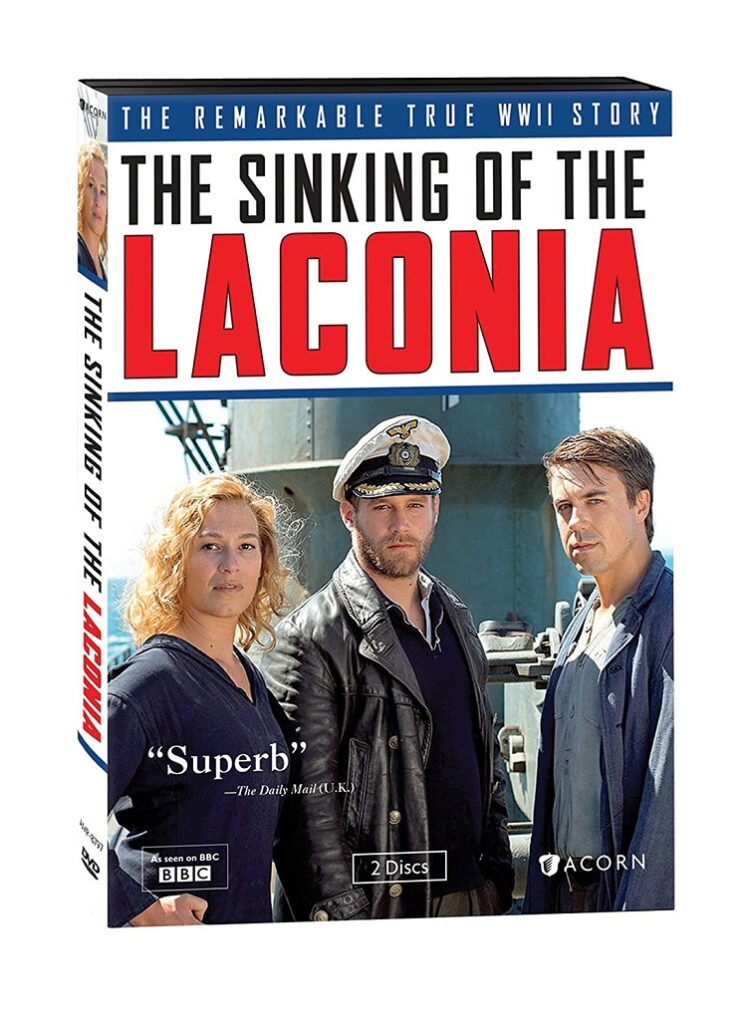
The second RMS Laconia was a Cunard ocean liner built by Swan, Hunter & Wigham Richardson as a successor to the Laconia of 1911 to 1917. Like her predecessor, sunk during the First World War, this Laconia would also be destroyed by a German U-boat. The German Korvettenkapitän (captain) Werner Hartenstein then staged a dramatic rescue effort, which involved assistance from additional German U-boats he contacted. It became known as the “Laconia Incident.” Those are the dry facts, but as the newly released The Sinking of the Laconia (2011) two-DVD set from Acorn demonstrates, the incident was likely the most emotional experience those involved would ever face.
To be clear, Werner Hartenstein was not Oskar Schindler, who initially saw World War II as a fantastic business opportunity. As Steven Spielberg’s Academy Award-winning Schindler’s List (1993) dramatically illustrates however, Schindler’s basic sense of decency took over as he began “hiring” Jews to work in his factories, thus saving their lives.
In the case of the Laconia, Korvettenkapitän Hartenstein (Ken Duken) fired torpedoes at what he thought was a British passenger ship ferrying soldiers to west Africa. It was September 12, 1942 and on-board the Laconia were 268 British Army soldiers, 160 Polish soldiers, around 1,800 Italian prisoners of war, and 80 civilians. As the ship was sinking, Hartenstein surfaced, looking to capture British officers, and realized that there had been civilians and Axis POWs aboard. He commenced rescue operations, and radioed for help. When more German subs arrived, he ordered white flags bearing the red-cross to be flown, to indicate that they were on a rescue mission.
The American bombers who flew in to investigate ignored the flags, and fired upon the U-Boats. The Germans had no choice but to return all survivors to the lifeboats, and descend. They were 600 hundred miles off the west African coast, and very few survived the lifeboat journey.
One of the elements that makes The Sinking of the Laconia so poignant are the simple human interactions. When Hartenstein’s crew questions his decision to engage a rescue mission, he tells them that it is “the rule of the sea.” As the two sides work together out on the open water, with no land in sight, the war seems a very distant thing. In fact, both the British and the Germans remark that it reminds them of the unofficial “Christmas truce” during World War I, where combat was halted by British and German “grunts” in the trenches, for the sake of the holiday, as seen in dramatized in Christian Carion’s Joyeux Noel. When this breach was later discovered, British General Sir Horace Smith-Dorrien, ordered that no further “truces” would ever take place again.
How ironic then that a similar order would go out after the Laconia Incident, this time from the German Admiral Karl Donitz (Thomas Kretschmann). It came to be known as the “Laconia Order,“ and forbade submarine commanders from rescuing survivors of torpedoed ships. Admiral Donitz was later convicted at Nuremburg of war crimes in part due to this order.
The Sinking of the Laconia first aired on BBC2 in January 2011, then in the United States on the Ovation Channel in April 2012. This marks the DVD debut of the program, with a total running time of 171 minutes. The main extra attraction is a highly engaging 29-minute documentary titled “The Sinking of the Laconia: Survivor’s Stories.”
As a post-script, after the incident, Korvettenkapitän Werner Hartenstein was offered a desk job for the remainder of the war. He chose to continue his U-Boat command and was killed in action by a depth charge in 1943. The ironies continue to pile-on as this partially subtitled film is credited as a British-German production.
As is so often the case with these BBC programs, the excellence of the story, acting, and location filming is top-notch. In fact, I believe The Sinking of the Laconia to be of feature-film quality, it is so well-done. The film is also a fascinating dramatization of a lesser-known, yet incredible incident in during World War II.